Sony SAL75300 75-300mm f4.5-5.6 lens review
-
-
Written by Gordon Laing
Quality

|
Pictured below from left to right are the standard Sony 18-70mm kit lens at 18 then 70mm, followed by the Sony 75-300mm at 75, then 300mm. It’s clear from the photo that both lenses share very similar styling and the build quality is also essentially to the same budget, but solid standard.
The 75-300mm measures 71x122mm (diameter by length) and extends a further 56mm using a single barrel section when zoomed-into 300mm. The filter thread measures 55mm and the lens weighs 460g. A lens hood is supplied.
The 75-300mm employs an optical design of 13 elements in ten groups with seven aperture blades and has a closest focusing distance of 1.5m. The lens does not employ internal focusing and actually extends by a further 13mm throughout its focusing range. The front section also rotates while focusing, which is annoying for users of polarising filters. There’s no focus distance scale on the lens, so it’s really designed mostly for AF operation.
Focusing on the 75-300mm wasn’t particularly quick with the lens taking a good second to shift through its entire range. The motors and gearing were quite audible too, and this could prove distracting if you’re shooting in a quiet room or environment. To be fair, it’s only a little louder than the standard 18-70mm kit lens when focusing, but then that isn’t exactly a quiet operator. If the noise of the kit lens doesn’t bother you though, the 75-300mm shouldn’t cause any nasty surprises.
Sony 75-300mm coverage with Sony A100
The Sony 75-300mm lens is designed to compliment the standard 18-70mm kit lens, and indeed they’re often sold as a twin bundle with the A100. Since the 5mm difference where one stops and the other starts is essentially insignificant, the pair offer a wide range of 18-300mm, or an equivalent of 27-450mm, delivering wide angle to long telephoto capabilities.
To illustrate this coverage in practice we took a series of images on a tripod from exactly the same position with each lens at its shortest and longest focal lengths. Below is the coverage offered by the standard 18-70mm kit lens, which can capture wide landscapes while zooming-in beyond the 55mm maximum of most kit lenses to deliver good short telephoto capabilities.
Sony Alpha DSLR-A100 with DT 18-70mm | ||
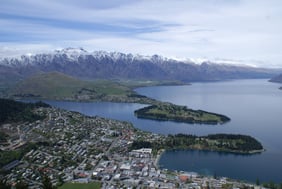 |  | |
| 18-70mm at 18mm, f8 (27mm equivalent) | 18-70mm at 70mm, f8 (105mm equivalent) | |
Below are examples of the 75-300mm lens at its shortest and longest focal lengths taken from the same spot just moments later. It essentially takes over where the standard kit lens stops, taking you from short to long telephoto. The result at the 300mm focal length, equivalent to 450mm, as seen below on the right, is so tight it looks like many of the 100% crops from our standard outdoor test compositions. It’s important to remember though this is the actual coverage of the entire 10 Megapixel frame, and a 100% crop would pretty much isolate only a couple of buildings.
Sony Alpha DSLR-A100 with 75-300mm | ||
 | 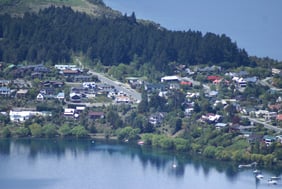 | |
| 75-300mm at 75mm, f8 (113mm equivalent) | 75-300mm at 300mm, f8 (450mm equivalent) | |
Sony 75-300mm with Super SteadyShot
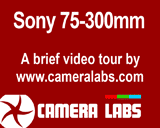
|
The Sony Alpha A100 features Super SteadyShot which means any lens you attach enjoys anti-shake capabilities. This is one of the big selling points of the A100 and having seen it perform well with the 18-70mm kit lens we were keen to see how effective it would be with the longer 75-300mm. Since the 75-300mm has an effective range of 113-450mm, traditional SLR technique would recommend using a shutter speed of 1/450 or higher to avoid camera-shake when fully zoomed-in. This figure of course varies with every person and on the conditions of the day, but for the example below we found we could safely handhold the 75-300mm when fully zoomed-in at a shutter speed of 1/300 and enjoy a sharp result without stabilisation. The big question is how Super SteadyShot would handle slower exposures.
Sony Alpha DSLR-A100 with 75-300mm | ||
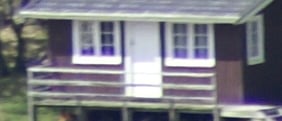 | 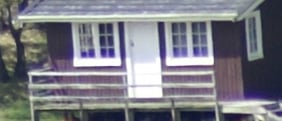 | |
|
Super SteadyShot Off. Exposure 1/200 sec 75-300mm at 300mm, f10 (450mm equivalent) |
Super SteadyShot On. Exposure 1/200 sec. 75-300mm at 300mm, f10 (450mm equivalent) | |
Above are two examples of a small building taken with and without Super SteadyShot. We used a focal length of 300mm (equivalent to 450mm) from quite a distance and a shutter speed of 1/200 of a second. We’ve cropped 282×121 pixel sections from the original 3872×2592 images and reproduced them here at 100%. Under the day’s conditions at this particular focal length we found shutter speeds below 1/300 without Super SteadyShot resulted in camera-shake – this is clear from the crop on the left, which at 1/200 is a little shaky. Switching on Super SteadyShot though eliminated any camera shake at this exposure as seen in the crop on the right.
While results will of course vary with different people and conditions, we found only a modest further reduction in shutter speed saw the camera shake return. Since we could safely handhold this particular composition without stabilisation or shake at 1/300, then the A100’s claimed three and a half stops of compensation should allow the same result at 1/30 or even slightly slower. We found shake returning at exposures of 1/100 and below though, which in this particular instance equates to about 1.5 stops of compensation. We should also mention the view when fully zoomed-in was quite shaky and much harder to accurately compose than lenses with built-in stabilisation. This is one major downside of in-camera stabilisation, as you can’t see the effect through the viewfinder.
Since in-camera stabilisation can also only physically shift the sensor by the same amount regardless of the lens you attach, it also becomes less effective as the focal length increases. This has always been Canon and Nikon’s argument for in-lens stabilisation which can be tailored to the focal length in question. The results above certainly show the A100’s anti-shake system offering lesser compensation at longer focal lengths than it does for shorter ones, but again this is a single example from one person on one particular day. It is however a subject we’re examining closely and look forward to retesting the Sony A100 with other long lenses in the future to see whether its anti-shake effectiveness can maintain the 3.5 stops of compensation available at shorter focal lengths.
Outdoor scene – Sony 75-300mm vs Sony 18-70mm
Sony SAL75300 75-300mm lens results continued…
Outdoor / Resolution / Corner sharpness / Fringe and macro / Geometry / Vignetting
|
 |
To compare real-life performance we shot the same scene with the Sony 75-300mm and Sony 18-70mm using the Sony Alpha A100 within a few moments of each other using the camera’s best quality JPEG and lowest ISO settings. We set the 75-300mm to 75mm and the 18-70mm to 70mm for the closest match, although the former will of course produce a slightly smaller field. We also acknowledge we’re comparing the wide-end of one lens against the long end of another, but it still illustrates any optical differences when switching from one range to the next. |
|
The image above was taken with the Sony 75-300mm at 75mm f9 using the Sony A100 body at a sensitivity of 100 ISO; the original JPEG measured 2.76MB. Apertures of f8 were selected for optimum sharpness with each lens. The crops are taken from the upper left, center and lower right portions of the originals. The three crops below exhibit very similar degrees of detail and at first glance there’s little to differentiate them. At closer examination though, even with just 5mm longer focal length, the 75-300mm is delivering tighter crops allowing greater separation of lines, but there’s arguably slightly greater detail in the 18-70mm samples. As our technical resolution results show on the next page, the 18-70mm at 70mm out-performs the 75-300mm at 75mm, so if you’re shooting around this focal length, you’ll get a better result with the shorter lens, but as this page shows, it’s still pretty close. |
Sony 75-300mm at 75mm Using Sony Alpha A100 |
Sony 18-70mm at 70mm Using Sony Alpha A100 | |
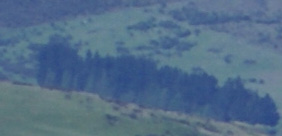 | 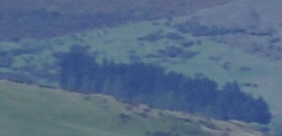 | |
1/200, f8, 100 ISO |
1/200, f8, 100 ISO | |
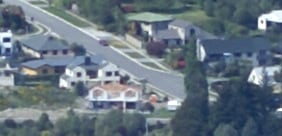 | 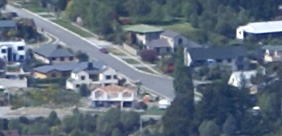 | |
1/200, f8, 100 ISO |
1/200, f8, 100 ISO | |
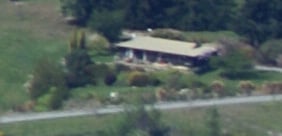 | 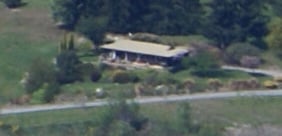 | |
1/200, f8, 100 ISO |
1/200, f8, 100 ISO |
Sony 75-300mm vs Sony 18-70mm resolution comparison
Sony SAL75300 75-300mm lens results continued…
Outdoor / Resolution / Corner sharpness / Fringe and macro / Geometry / Vignetting
|
 |
To measure and compare the Sony 75-300mm’s resolving power we photographed the Enhanced Digital Camera Resolution Chart with it and the DT 18-70mm kit lens using the Sony A100 body set to its best quality JPEG and default image tone and sharpening settings. The crops are taken from the original images, saved as High Quality JPEGs in Photoshop CS2 and presented here at 100%. Each number represents 100 lines per picture height (lpph), so a figure of 20 means a resolution of 2000 lpph. |
|
We tested the Sony 75-300mm with the Sony A100 body at a focal length of 75mm and compared it to the DT 18-70mm at a focal length of 70mm. The sharpest results on both lenses were found at an aperture of f8, where the 75-300mm lens delivered 2000 and 2050 lpph of horizontal and vertical resolution respectively. 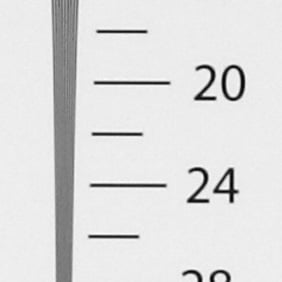 This result is measurably lower than the 18-70mm kit lens, at their closest focal lengths anyway, so if you’re shooting at around the 70mm point, you’ll get better results using the kit lens zoomed-into 70mm than the 75-300mm zoomed-out to 75mm. To be fair, the Sony 18-70mm kit lens is better than most though, and the A100’s resolving power with the 75-300mm aren’t far off the Canon EOS 400D / XTi with its 18-55mm kit lens. |
Sony 75-300mm at 75mm Using Sony Alpha A100 |
Sony 18-70mm at 70mm Using Sony Alpha A100 | |
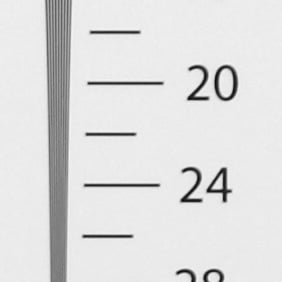 | ||
2000 lpph, 75-300mm at 75mm, f8, 100 ISO |
2150 lpph, DT 18-70mm at 70mm, f8, 100 ISO |
Sony 75-300mm at 75mm Using Sony Alpha A100 |
Sony 18-70mm at 70mm Using Sony Alpha A100 | |
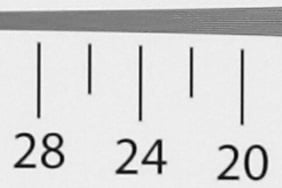 | 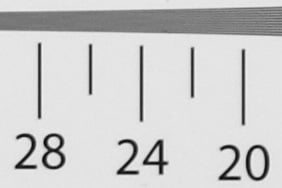 | |
2050 lpph, 75-300mm at 75mm, f8, 100 ISO |
2100 lpph, DT 18-70mm at 70mm, f8, 100 ISO |
Sony 75-300mm vs Sony 18-70mm corner sharpness
Sony SAL75300 75-300mm lens results continued…
Outdoor / Resolution / Corner sharpness / Fringe and macro / Geometry / Vignetting
|
 |
To compare the corner sharpness of the Sony 75-300mm against the Sony 18-70mm, we photographed the Enhanced Digital Camera Resolution Chart with each lens at their shortest and longest focal lengths and various apertures in Aperture Priority mode. The cameras used for testing each lens were set to their best quality JPEG and default image tone and sharpening settings. The crops are taken from the extreme lower left corner of the chart and presented here at 100%. |
Zoomed-out to its shortest focal length, the 75-300mm is slightly soft in the extreme corners until the aperture is closed right down to around f11 to f16. The 18-70mm kit lens is much sharper in the corners at 70mm, so if you want the best results at around this focal length, go for the 18-70mm kit lens and zoom it all the way in. Zoom the 75-300mm all the way in though and it performs much better in the extreme corners, although as seen in the crops below, it does exhibit some coloured fringing. |
Corner sharpness, wide angle
Sony 75-300mm using Sony Alpha A100 | ||||||
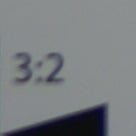 | 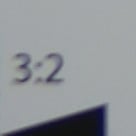 | 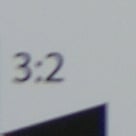 | 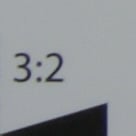 | |||
75-300mm at 75mm f4.5 |
75-300mm at 75mm f5.6 |
75-300mm at 75mm f8 |
75-300mm at 75mm f16 | |||
Sony 18-70mm using Sony Alpha A100 | ||||||
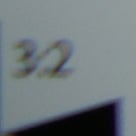 | 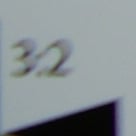 | 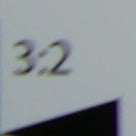 | 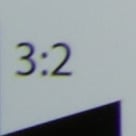 | |||
18-70mm at 18mm f3.5 |
18-70mm at 18mm f5.6 |
18-70mm at 18mm f8 |
18-70mm at 18mm f16 | |||
Corner sharpness, telephoto
Sony 75-300mm using Sony Alpha A100 | ||||||
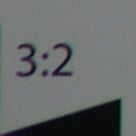 | 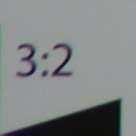 | 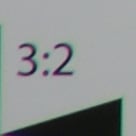 | 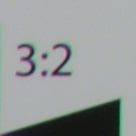 | |||
75-300mm at 300mm f5.6 |
75-300mm at 300mm f8 |
75-300mm at 300mm f11 |
75-300mm at 300mm f16 | |||
Sony 18-70mm using Sony Alpha A100 | ||||||
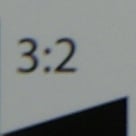 | 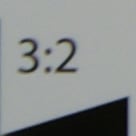 | 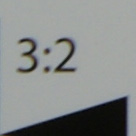 | 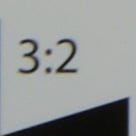 | |||
18-70mm at 70mm f5.6 |
18-70mm at 70mm f8 |
18-70mm at 70mm f11 |
18-70mm at 70mm f16 | |||
Sony 75-300mm vs Sony 18-70mm purple fringing comparison
Sony SAL75300 75-300mm lens results continued…
Outdoor / Resolution / Corner sharpness / Fringe and macro / Geometry / Vignetting
|
 |
To compare the purple fringing of the Sony 75-300mm against the Sony 18-70mm, we photographed a test chart with areas of very high contrast using each lens at their shortest and longest focal lengths and with their apertures wide open. The crops are taken from the upper left corner of the chart and presented here at 100%. Both lenses exhibit purple fringing at their shortest focal lengths, although the 75-300mm shows a very clean result when zoomed-into 300mm. |
Sony 75-300mm Using Sony Alpha A100 |
Sony 18-70mm Using Sony Alpha A100 | |||||
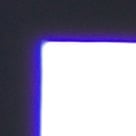 | 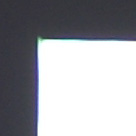 | 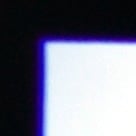 |  | |||
75-300mm at 75mm f4.5 |
75-300mm at 300mm f5.6 |
18-70mm at 18mm f3.5 |
18-70mm at 70mm f5.6 | |||
Sony 75-300mm vs Sony 18-70mm macro comparison
| To compare the macro capabilities of the Sony 75-300mm against the Sony 18-70mm, we photographed a custom chart at a focal length and distance which delivered the maximum possible reproduction. The dark lines are 10mm apart and the result is not cropped. Smaller areas are preferred in this test. |
Sony 75-300mm Using Sony Alpha A100 |
Sony 18-70mm Using Sony Alpha A100 | |
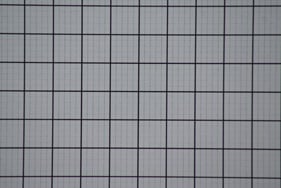 | 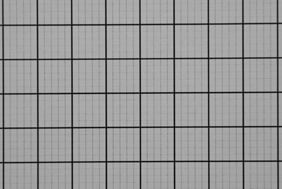 | |
75-300mm at 250mm f8 Max area of 98x66mm |
18-70mm at 70mm f8 Max area of 82x54mm |
| The best result we could get from the Sony 75-300mm was set at 250mm where it delivered an area measuring 98x66mm. The 18-70mm kit lens can deliver a smaller area though and at much closer range too, so is unsurprisingly a more practical option when it comes to macro work. |
Sony 75-300mm vs Sony 18-70mm wide-angle geometry comparison
Sony SAL75300 75-300mm lens results continued…
Outdoor / Resolution / Corner sharpness / Fringe and macro / Geometry / Vignetting
|
|
To compare the geometric distortion of the Sony 75-300mm against the Sony 18-70mm at their shortest focal lengths, we photographed a test chart consisting of a grid pattern at an aperture of f8. The images were then analysed with Imatest using 5th Order line calculation and the full areas presented here at a reduced resolution. Smaller percentages are better. Zoomed-out to 75mm, the Sony 75-300mm exhibited 2.04% barrel distortion. This isn’t particularly noticeable, although if you’re very sensitive to geometric distortion and wish to shoot at this focal length, you may prefer to use the 18-70mm kit lens zoomed-into 70mm, where it exhibits 0.27% pincushion distortion (as seen in the lower results). |
Sony 75-300mm Using Sony Alpha A100 |
Sony 18-70mm Using Sony Alpha A100 | |
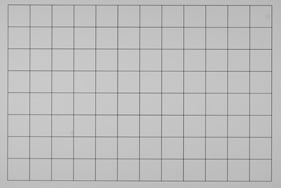 | 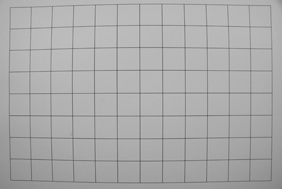 | |
75-300mm at 75mm f8 Distortion: 2.04% barrel |
18-70mm at 18mm f8 Distortion: 3.6% barrel |
Sony 75-300mm vs Sony 18-70mm telephoto geometry comparison
|
To compare the geometric distortion of the Sony 75-300mm against the Sony 18-70mm at their longest focal lengths, we photographed a test chart consisting of a grid pattern at an aperture of f8. The images were then analysed with Imatest using 5th Order line calculation and the full areas presented here at a reduced resolution. Smaller percentages are better. Zoomed-into its longest focal length, the Sony 75-300mm exhibits 0.9% pincushion distortion. |
Sony 75-300mm Using Sony Alpha A100 |
Sony 18-70mm Using Sony Alpha A100 | |
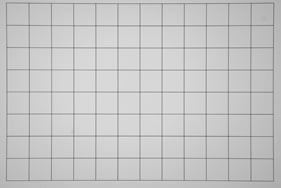 | 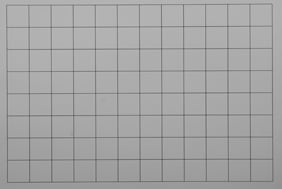 | |
75-300mm at 300mm f8 Distortion: 0.9% pincushion |
18-70mm at 70mm f8 Distortion: 0.27% pincushion |
Sony 75-300mm vs Sony 18-70mm wide-angle uniformity comparison
Sony SAL75300 75-300mm lens results
Outdoor / Resolution / Corner sharpness / Fringe and macro / Geometry / Vignetting
|
|
To compare the vignetting and light fall-off of the Sony 75-300mm against the Sony 18-70mm at their shortest focal lengths, we photographed a white target with a highly diffused filter; each lens was focused to infinity with its aperture wide open. The images were then analysed with Imatest and the full areas presented here at a reduced resolution. Bigger percentages are better. Light falls off to 73.5% of the maximum when it reaches the corners of the Sony 75-300mm at 75mm. This is a good result, although the 18-70mm zoomed-into 70mm, as seen in the second example, boasts even less fall-off at just 87.7%. So given the choice between the two at around the 70mm focal length, the 18-70mm kit lens is preferable in terms of the least light fall-off. |
Sony 75-300mm Using Sony Alpha A100 |
Sony 18-70mm Using Sony Alpha A100 | |
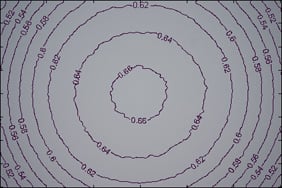 | 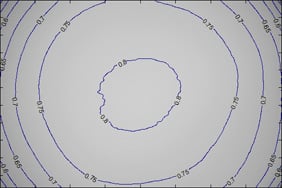 | |
75-300mm at 75mm f4.5 Mean corner fall-off: 73.5% |
18-70mm at 18mm f3.5 Mean corner fall-off: 63.3% |
Sony 75-300mm vs Sony 18-70mm telephoto uniformity comparison
To compare the vignetting and light fall-off of the Sony 75-300mm against the Sony 18-70mm at their longest focal lengths, we photographed a white target with a highly diffused filter; each lens was focused to infinity with its aperture wide open. The images were then analysed with Imatest and the full areas presented here at a reduced resolution. Bigger percentages are better. Zoomed-in to its longest focal length, the 75-300mm performs similarly to how it does when zoomed-out: light falls off to 75.1% of the maximum, which means darkening in the corners won’t be particularly noticeable at either end of its focal range. |
Sony 75-300mm Using Sony Alpha A100 |
Sony 18-70mm Using Sony Alpha A100 | |
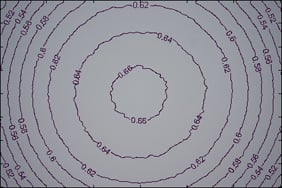 | 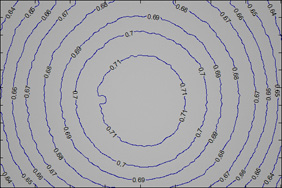 | |
75-300mm at 300mm f5.6 Mean corner fall-off: 75.1% |
18-70mm at 70mm f5.6 Mean corner fall-off: 87.7% |




